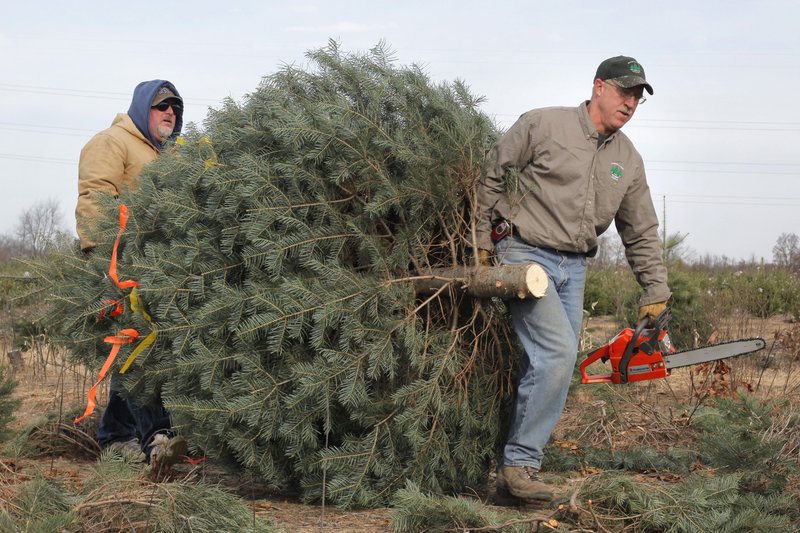This Christmas, Vicki Freshley will proudly show off her prized fake fir.
In her eyes, it’s a beautiful thing, as nice as any real Christmas tree: 9 feet tall, emerald and fluffy, and decked out with so many eye-popping trimmings that her brother stopped in his tracks when he saw it and said, “Oh my God.”
But in the eyes of many environmentalists, Freshley could have made a better choice than buying that artificial tree last year at a Costco near her home in Gaithersburg, Md. Even tree huggers are encouraging Americans to go out every December and either buy a real tree from a lot or go to a farm, cut one down and drag it home, because tree farms are good for the atmosphere.
Artificial trees have been gaining ground in American living rooms — 50 million fake trees vs. 30 million fresh ones, according to the two competing industry groups, the long-standing National Christmas Tree Association (which supports real trees) and the more recently formed American Christmas Tree Association (which defends artificial trees).
But the real trees aren’t going down without a fight. The battle comes to a head this weekend, two weeks before Christmas. Saturday, in fact, was the Christmas trees’ own version of Black Friday, and was expected to be the highest traffic day in tree buying. And at the forefront of the argument is which kind of tree is better for the environment.
For a symbol of yuletide cheer, the tree brings out some pretty hostile rhetoric. One side’s website says fake Christmas trees were invented as oversize “green toilet brushes.” The other’s claims that “after two weeks of being indoors, a live Christmas tree emitted significant amounts of mold spores.”
Each side offers what it considers compelling evidence.
Real fir, along with pine and spruce, has benefits beyond a fresh pine smell that says Christmas, supporters say. Their purchase encourages farmers to keep planting acres of trees that absorb carbon dioxide from the air, soak up storm-water runoff full of nutrient and sediment pollution before it pours into waterways, and provide habitat for wildlife.
The real trees also have a smaller carbon footprint than ones made with plastic and shipped mostly from factories in China, said Stephanie Flack, Potomac River Project director for the Nature Conservancy. “This time of year, while people are thinking of gifts they get from under the tree, they should be thinking about the gift from trees,” Flack said.
But the American Christmas Tree Association would say that Freshley’s fake-tree purchase was the greener choice. The group cites a study to support its view that fake trees have a lower carbon footprint if consumers hold on to fake trees for six to 10 years, considering the energy it takes to chop, water and transport fresh trees annually.
In the United States, about 15,000 farms grow 400 million trees and employ 100,000 full-time and part-time workers, according to the National Christmas Tree Association. It can take anywhere from four years to 15 years to grow a tree of typical height, with an average growing time of seven years.
A small fraction are cut for customers over the holidays, leaving 90 percent to suck up carbon to develop bark, sap and pine needles the rest of the year. Environmental groups estimate that an acre of firs absorbs more than 11,000 pounds of carbon dioxide annually.
Freshley, however, was very clear about why she bought her plastic tree.
“I love it because I don’t have needles on the floor,” Freshley, who sells stationery, said of her tree while shopping for decorations with her son, Shawn, at a Gaithersburg store. “I can take it apart myself. I don’t have to wait for my husband to drag it out of the house.
“I had my old tree for 10 years before I bought the new one,” Freshley said, which is what the American Tree Association recommends.
But she had a flash of doubt about her purchase when told of the real-vs.-fake-tree debate. “It sounds so insensitive” to buy a fake, she said.
But then Freshley cheerfully recalled the look on her brother’s face when he visited her home. “He said it’s beautiful,” she said. “He said, ‘Can you decorate for us?’“
Send questions/comments to the editors.



Success. Please wait for the page to reload. If the page does not reload within 5 seconds, please refresh the page.
Enter your email and password to access comments.
Hi, to comment on stories you must . This profile is in addition to your subscription and website login.
Already have a commenting profile? .
Invalid username/password.
Please check your email to confirm and complete your registration.
Only subscribers are eligible to post comments. Please subscribe or login first for digital access. Here’s why.
Use the form below to reset your password. When you've submitted your account email, we will send an email with a reset code.